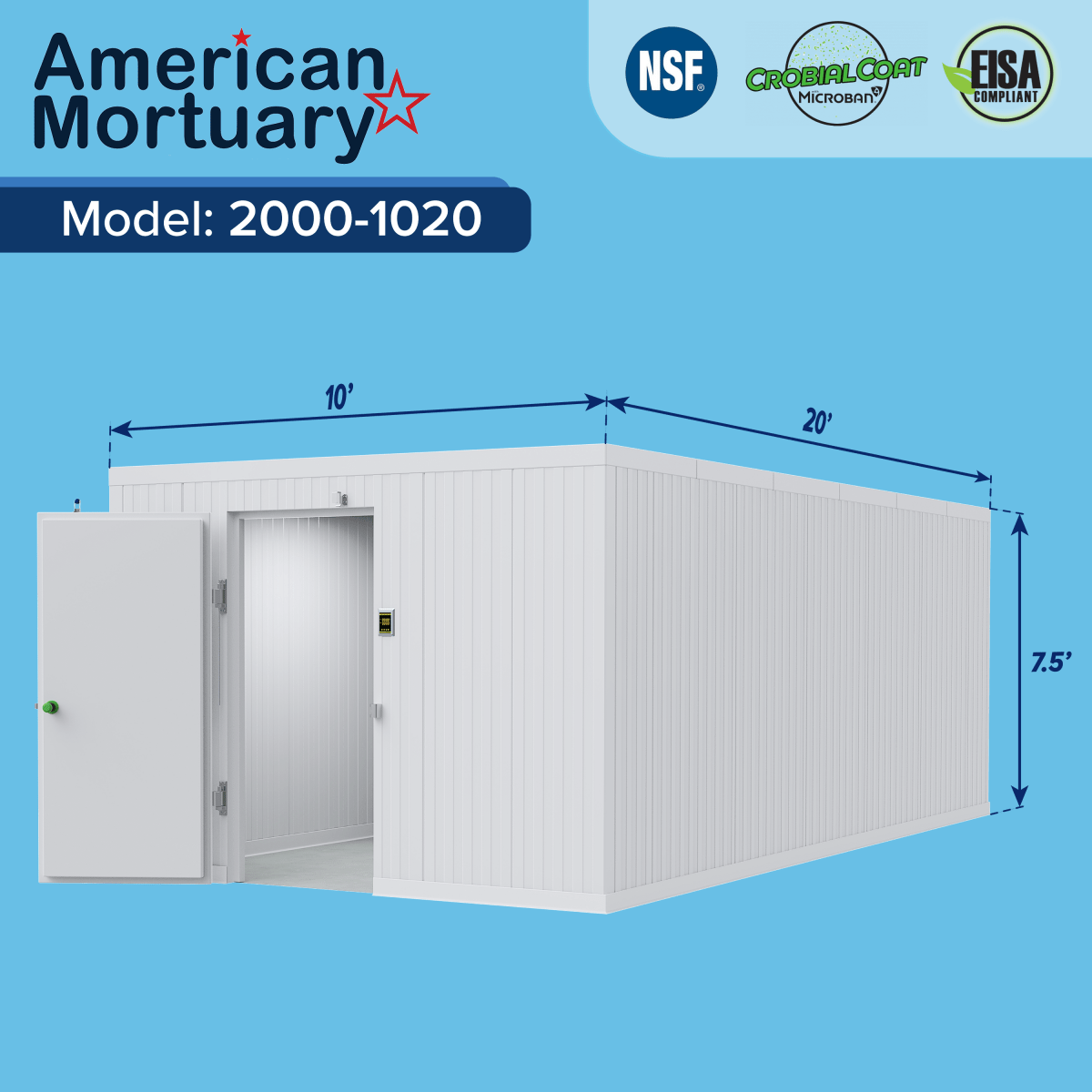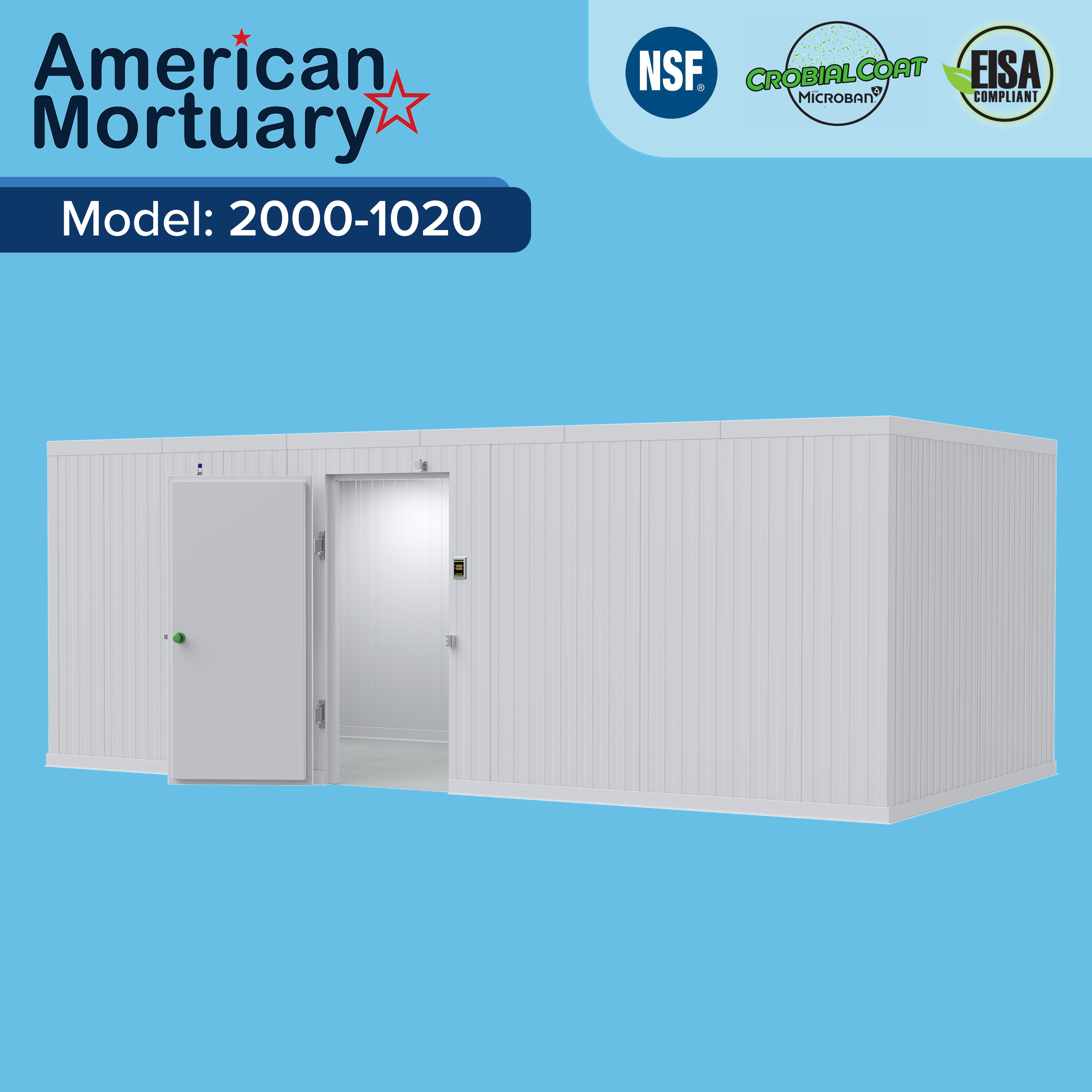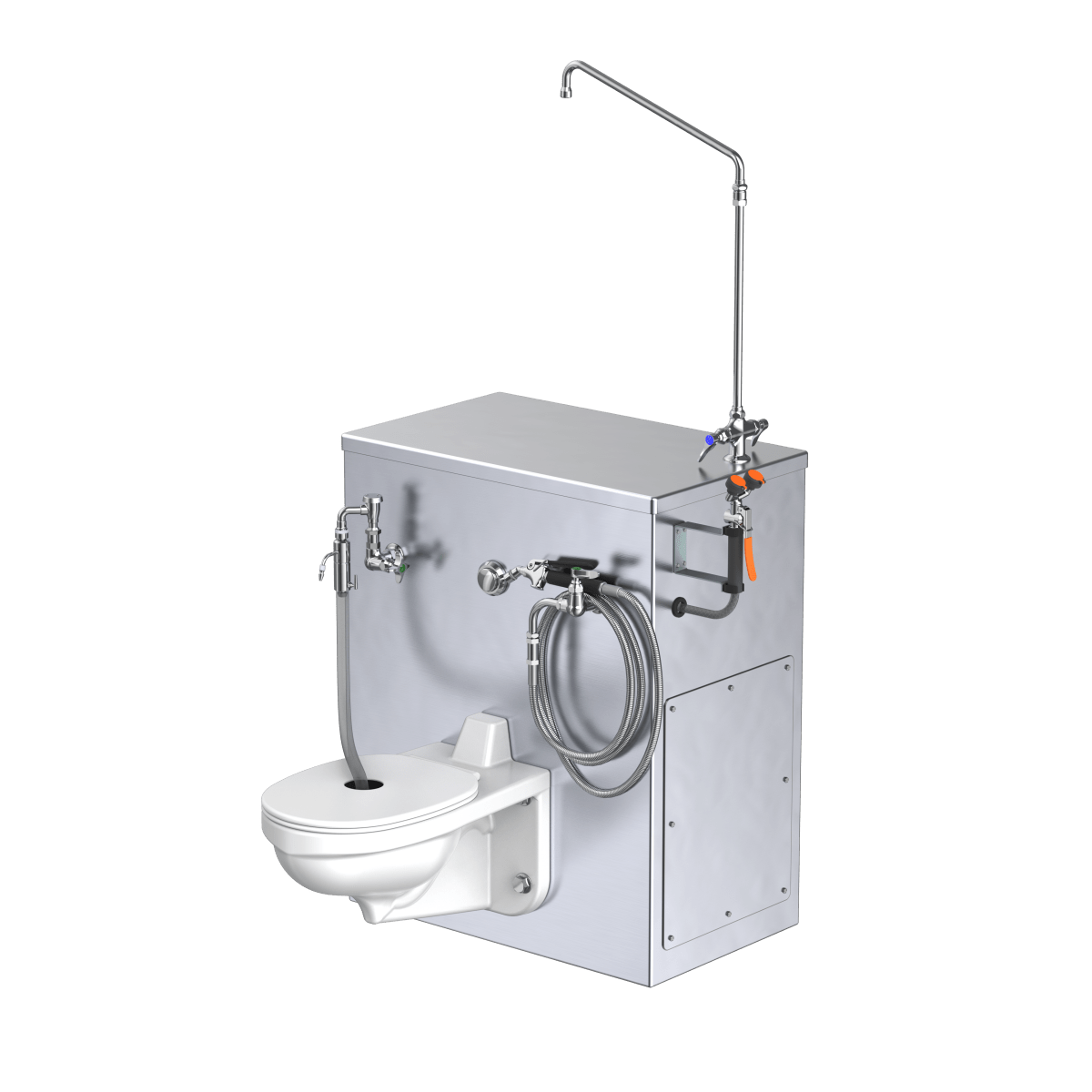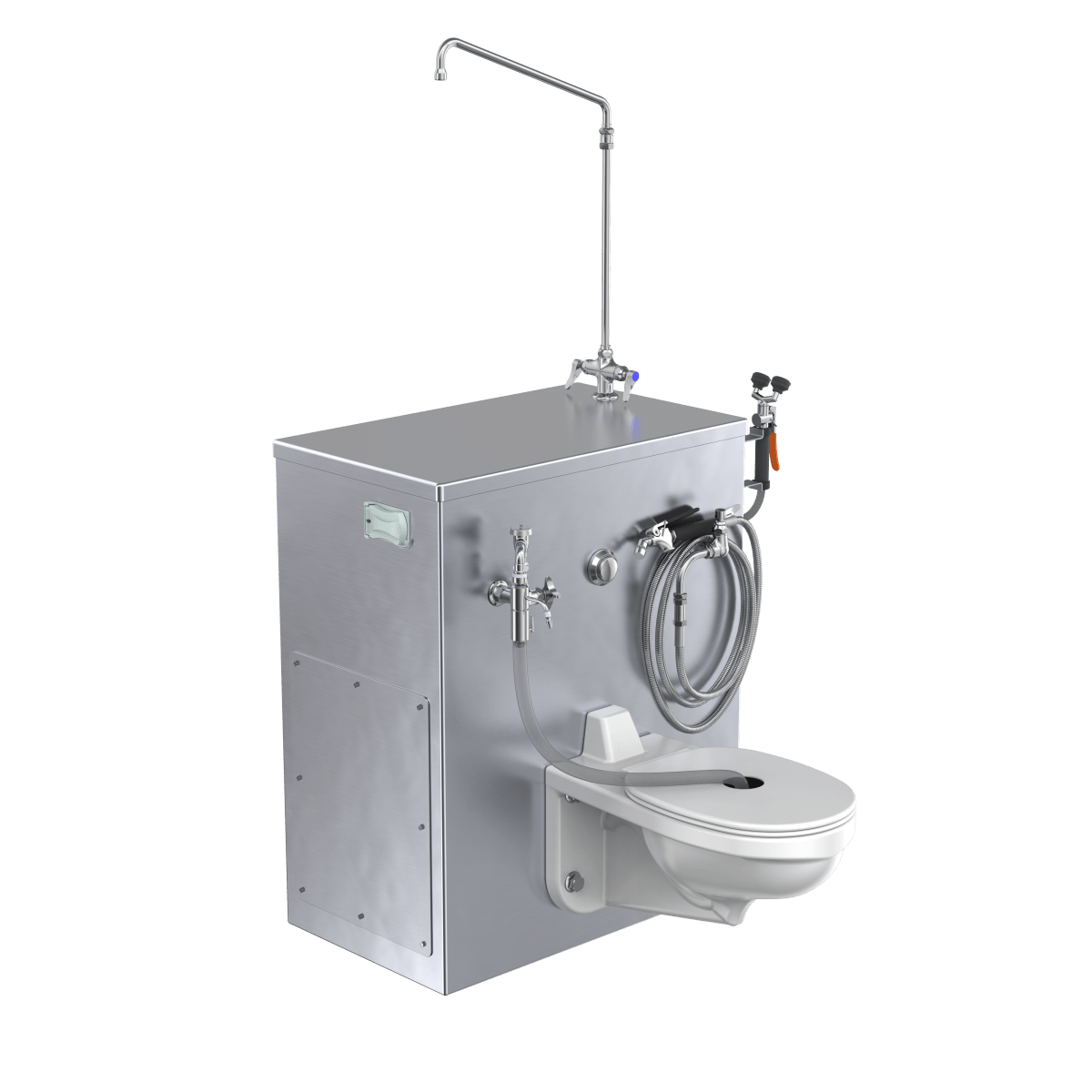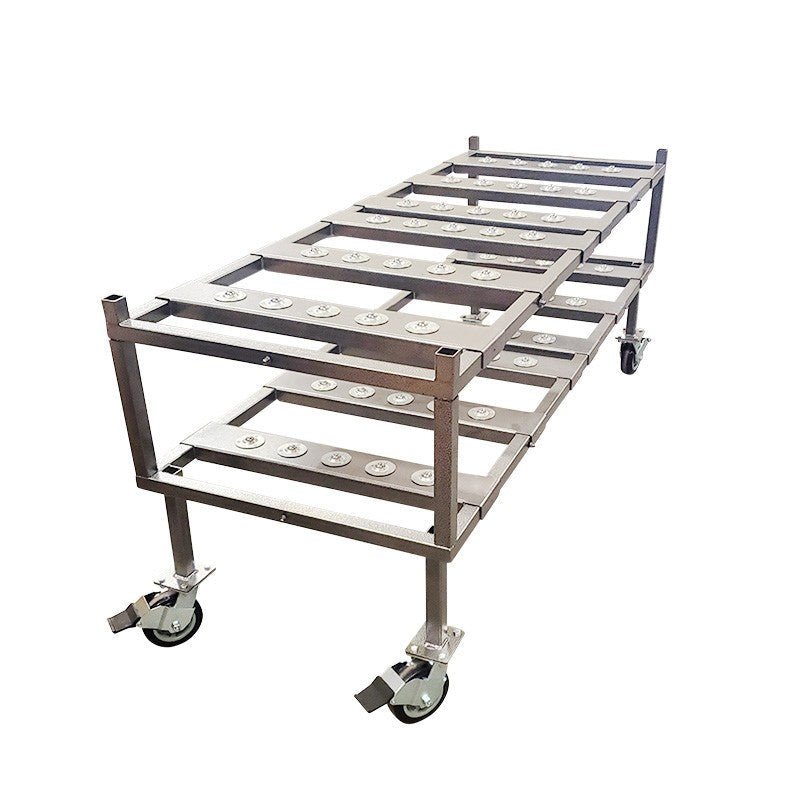Why Understanding Human Composting Timelines Matters for Modern Death Care
How long does it take to compost a body is becoming a critical question for funeral directors as natural organic reduction gains legal acceptance across the United States. The answer is surprisingly straightforward: most human composting processes take between 8-12 weeks to complete.
Quick Answer:
- Total Timeline: 8-12 weeks (2-3 months)
- Active Vessel Phase: 5-7 weeks
- Curing Phase: 3-5 weeks
- Accelerated Methods: As fast as 4-6 weeks
- Trial Results: Less than 30 days in controlled studies
This eco-friendly alternative to burial and cremation transforms human remains into nutrient-rich soil through natural microbial processes. The process involves placing remains in specialized steel vessels with organic materials like wood chips, alfalfa, and straw. Controlled temperature and aeration create optimal conditions for beneficial microbes to break down tissues while destroying pathogens. The result is approximately one cubic yard of clean, pH-balanced soil per body.
I'm Mortuary Cooler, a national supplier of mortuary equipment who has researched extensively into how long does it take to compost a body and the infrastructure requirements for natural organic reduction facilities.
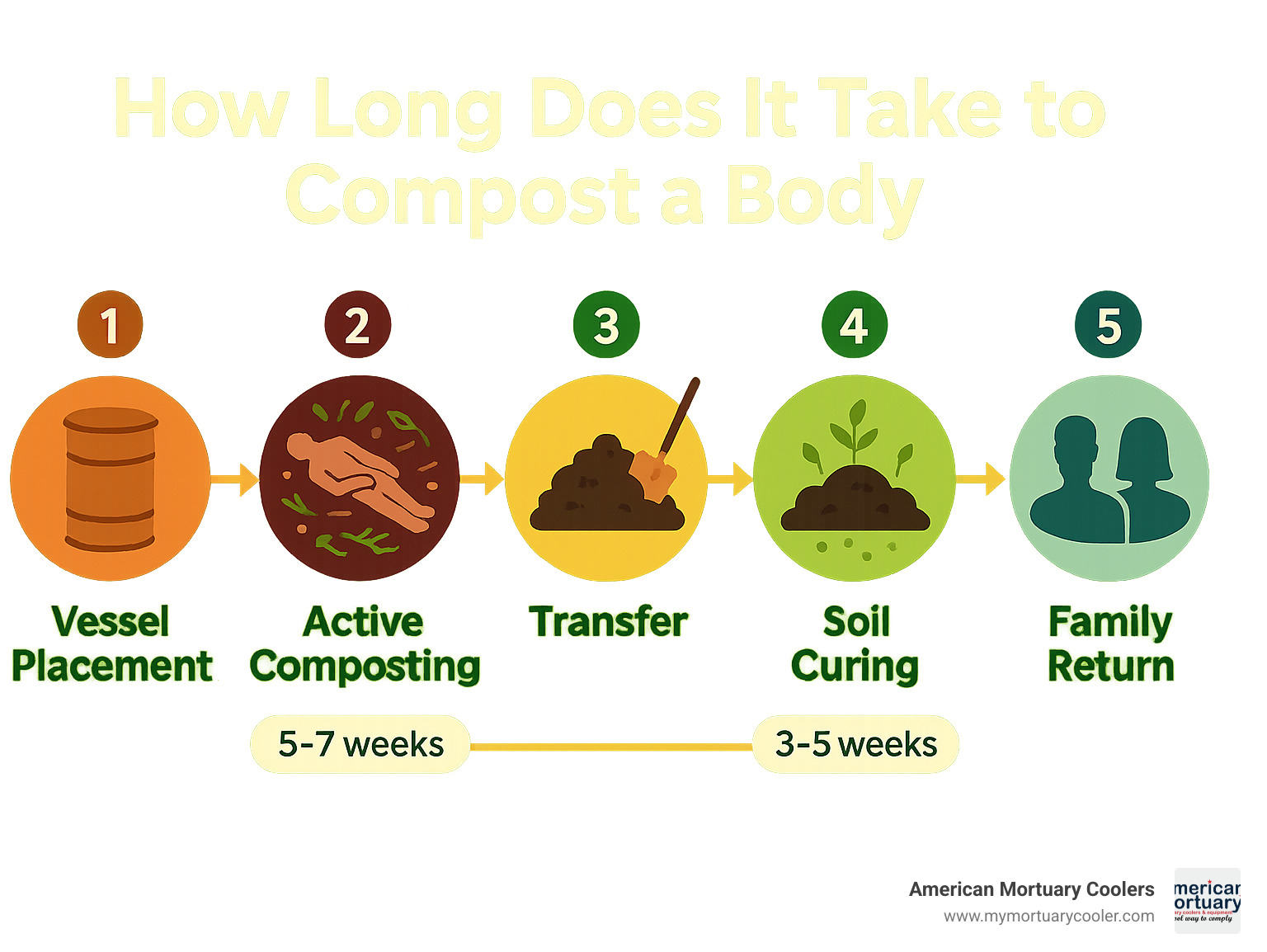
How long does it take to compost a body word guide:
What Is Human Composting and How Does It Work?
Human composting, officially called natural organic reduction (NOR), transforms human remains into rich, fertile soil using the same microbes that have been decomposing organic matter for millions of years.
The process works like a carefully managed compost pile. A body is placed in a specialized stainless steel vessel along with organic materials. Wood chips provide carbon, straw adds structure for airflow, and alfalfa contributes nitrogen - creating the perfect recipe for microbial activity.
As beneficial bacteria work, the decomposition process generates significant heat, with the core temperature reaching around 55°C (131°F). According to Scientific research on microbial decomposition, this temperature effectively destroys most disease-causing pathogens while preserving beneficial microbes that create healthy soil.
How long does it take to compost a body through this process? The entire journey unfolds in two main phases: an active vessel phase lasting 5-7 weeks, followed by a curing phase in aerated bins for an additional 3-5 weeks. The end result is approximately one cubic yard of clean, pH-balanced soil (between 6.5-7) that's perfect for supporting plant life.
For more details about the fundamentals, our Beginners Guide to Human Composting: What Is It? covers all the basics.
Key Components of a Composting Vessel
Modern human composting vessels are sophisticated steel chambers - typically measuring about 8 feet by 4 feet - designed to create perfect conditions for natural decomposition.
Forced aeration systems continuously pump fresh oxygen into the vessel, supporting the aerobic bacteria that make the process work efficiently. Moisture probes constantly monitor humidity levels, maintaining the optimal 40-60% moisture range. Temperature monitoring happens through multiple sensors that track internal heat to ensure the process stays within the optimal 130-160°F range.
What Happens to Bones, Teeth & Implants?
Bones and teeth don't fully decompose during the initial composting phase, but they do soften considerably. After the primary composting period ends, these softened bones are carefully removed and go through bone pulverization - they're mechanically ground into a fine powder that gets mixed back into the compost, adding essential phosphorus and calcium.
Medical implants require special handling. Pacemakers, artificial joints, and dental amalgam fillings are carefully identified and removed during safety screening. Dental fillings containing mercury receive particular attention, getting separated and disposed of through specialized channels to prevent contamination of the final soil product.
How Long Does It Take to Compost a Body?
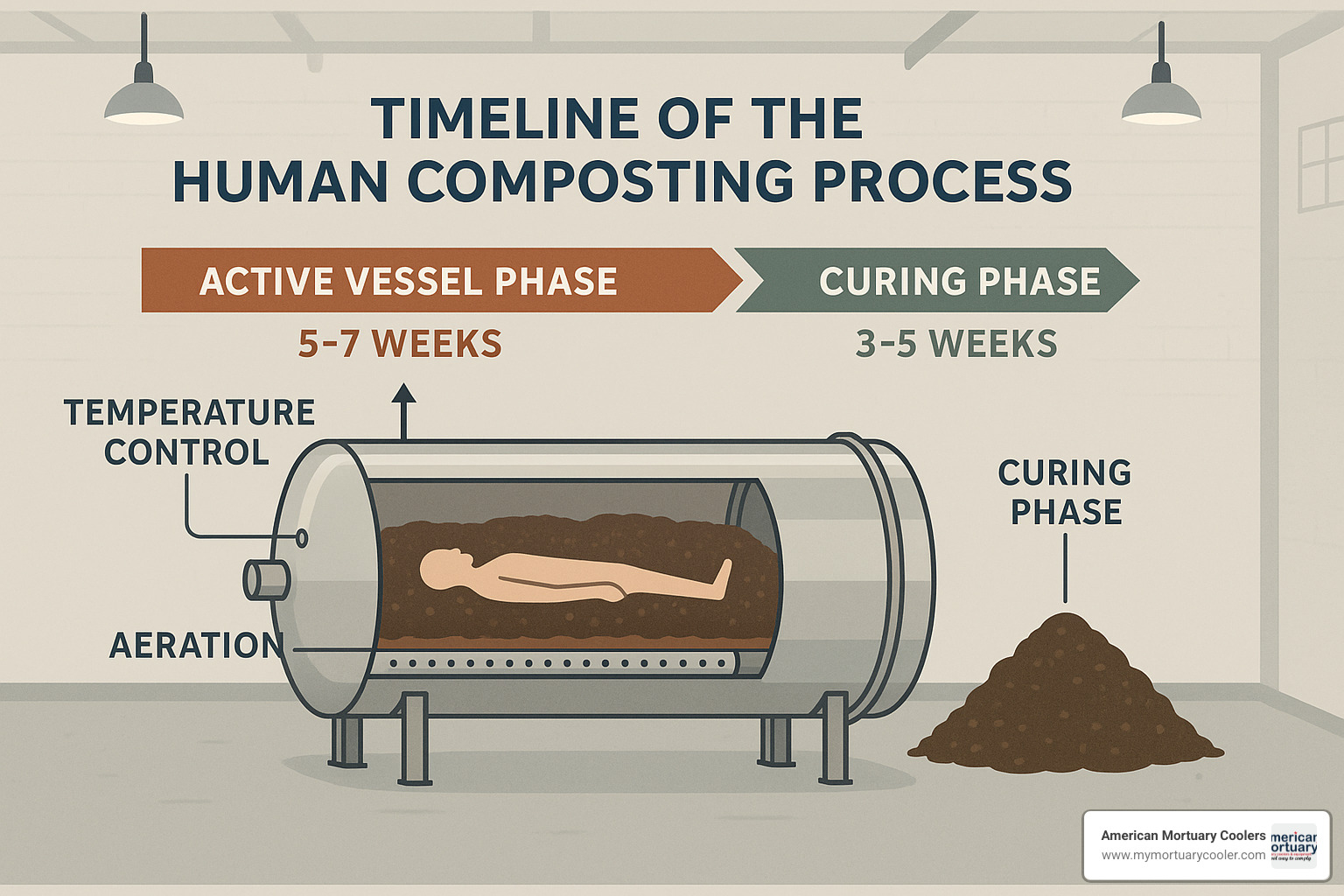
When families ask how long does it take to compost a body, the answer is reassuringly consistent across most facilities: 8-12 weeks from start to finish. This timeframe includes everything from initial placement to the moment families receive their loved one's transformed soil.
The process unfolds in two main stages. The active vessel phase takes about 5-7 weeks, where most of the actual decomposition happens inside the steel chamber. Then comes the curing phase, lasting 3-5 weeks, where the material rests in aerated bins to stabilize into healthy soil.
Some facilities have developed accelerated methods that can complete the entire process in 4-6 weeks. These faster timelines require more intensive monitoring and specialized equipment, but they're becoming increasingly popular as the technology improves.
Interestingly, controlled research trials have achieved even more dramatic results. Scientists have successfully composted bodies in less than 30 days under optimal laboratory conditions. However, commercial facilities typically stick with the longer timelines to ensure complete pathogen destruction and soil safety.
The beauty of this process lies in its predictability. Unlike traditional burial, which can take decades for natural decomposition, or cremation, which happens in just a few hours but carries significant environmental costs, human composting offers families a meaningful middle ground.
Timeline Breakdown: How Long Does It Take to Compost a Body in Each Phase?
Understanding each phase helps families know what to expect during their loved one's change journey. The process unfolds like a carefully choreographed dance between science and nature.
The vessel phase begins immediately after placement. During the first week, microbial activity starts slowly as beneficial bacteria begin breaking down soft tissues. By week two, the temperature inside the vessel rises to around 55°C, creating the perfect environment for decomposition while destroying harmful pathogens.
Weeks three through five represent the most active period. This is when the majority of tissue breakdown occurs, and families often receive their first progress update from facility staff. The composting mass reaches its peak temperature during this time, ensuring complete pathogen elimination.
The curing phase starts around week six when the material is removed from the vessel and screened. Bones are carefully separated and pulverized before being reintegrated into the compost. Any medical implants or dental work are removed and handled according to safety protocols.
During the final 3-5 weeks, the material rests in aerated bins where it continues to mature into stable soil. Staff monitor pH levels, moisture content, and conduct final safety testing. The soil reaches its ideal pH of 6.5-7 during this phase, perfect for supporting plant growth.
Many facilities provide regular temperature milestone updates to families throughout the process, helping them feel connected to their loved one's change.
Comparing Durations: How Long Does It Take to Compost a Body vs. Burial & Cremation?
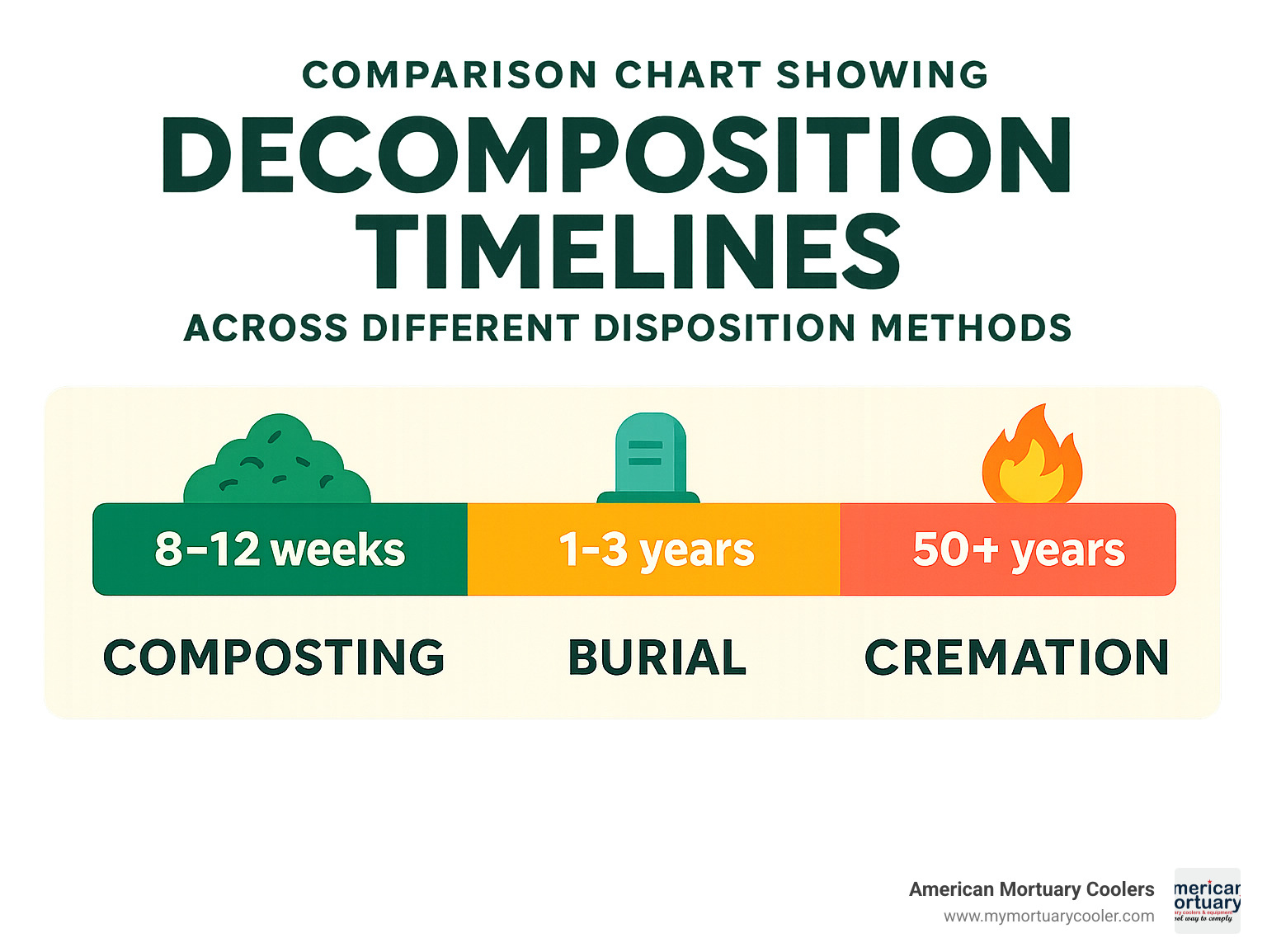
| Method | Duration | Energy Use | Environmental Impact |
|---|---|---|---|
| Natural Organic Reduction | 8-12 weeks | 87% less than cremation | Sequesters ~1 ton CO2 |
| Green Burial | 1-3 years | Minimal | Positive (no chemicals) |
| Embalmed Burial | 50+ years | Moderate | Negative (chemicals, resources) |
| Cremation | 2-3 hours | High | High CO2 emissions |
The timeline comparison reveals why how long does it take to compost a body has become such an important question for environmentally conscious families. Traditional embalmed burial can preserve remains for over 50 years, but this extended timeline comes at the cost of using toxic chemicals and valuable land resources.
Green burial offers a more natural approach, typically taking 1-3 years for complete decomposition. While this is more environmentally friendly than embalming, it still requires significant land use and doesn't create the beneficial soil amendment that human composting produces.
Cremation happens fastest at just 2-3 hours, but it releases approximately 418 pounds of CO2 per body - equivalent to the emissions from driving 750 kilometers. The high energy requirements and carbon footprint make it less appealing to families seeking sustainable options.
Human composting strikes the perfect balance. The 8-12 week timeline allows families to complete the grieving process while their loved one transforms into something life-giving. The process uses 87% less energy than cremation while actually sequestering about one ton of CO2 rather than releasing it into the atmosphere.
Step-by-Step Guide to the Human Composting Process
The human composting journey unfolds over the 8-12 week timeline in five distinct phases.
Phase 1 - The Laying In marks the beginning. Your loved one is gently placed in a biodegradable shroud in the steel vessel, surrounded by the organic matrix of wood chips, alfalfa, and straw. This ceremonial beginning allows families to witness and participate if they choose.
Phase 2 - Active Aeration starts the biological process. Oxygen flows continuously into the vessel, creating the perfect environment for beneficial microbes to thrive. The temperature gradually rises to around 131°F - warm enough to eliminate harmful pathogens while preserving good bacteria.
Phase 3 - Turning and Monitoring ensures smooth progress. Staff check temperature, moisture, and pH levels daily, making adjustments to keep conditions optimal. This careful attention is why how long does it take to compost a body stays consistent across facilities.
Phase 4 - Curing and Screening reveals the change. After 5-7 weeks in the vessel, contents are carefully removed and screened. Bone fragments are respectfully pulverized and reintegrated, adding valuable calcium and phosphorus. The material then moves to aerated curing bins for several more weeks.
Phase 5 - Soil Return completes the circle of life. The finished compost undergoes rigorous testing to ensure safety standards. Families receive approximately one cubic yard of rich, dark soil with a pH between 6.5-7 - perfect for nurturing new plant life.
For technical details about the equipment that makes this possible, our guide All About Human Composting Vessels provides comprehensive coverage.
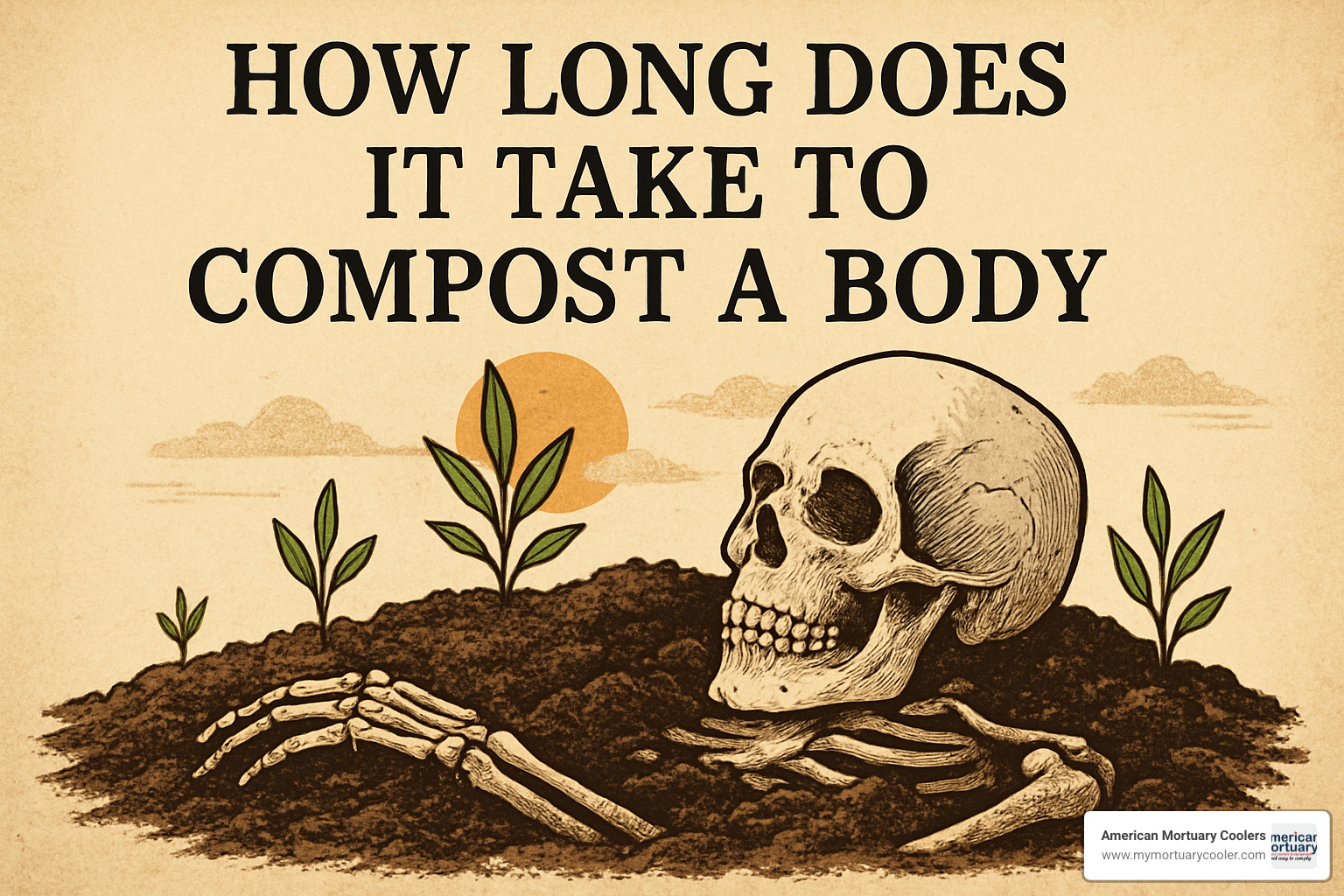
Family Participation & Personalization Options
Memorial gatherings during initial placement allow families to say final goodbyes in the composting environment. Biodegradable tributes let families include personal touches like fresh flowers, handwritten letters on natural paper, or small wooden mementos that become part of the organic matrix.
Donation options provide alternatives for families overwhelmed by receiving a full cubic yard of soil. Many facilities partner with conservation projects where the nutrient-rich compost can restore damaged ecosystems.
Memorial plantings create living tributes using the incredibly nutrient-rich soil - perfect for memorial trees, flower gardens, or food forests. For more memorial service inspiration, celebration of life ideas offers meaningful approaches.
Factors That Influence Composting Duration & Quality
Several factors affect how long does it take to compost a body, though most facilities achieve consistent 8-12 week timelines by adjusting variables to ensure uniform results.
Body composition plays a role in processing time. Facilities routinely adjust temperature, moisture, and aeration parameters to ensure consistent results regardless of individual differences.
The moisture balance is critical - the organic matrix must maintain 40-60% moisture content. Too little slows microbial activity; too much creates anaerobic conditions with unpleasant odors.
Temperature control determines safety and efficiency. The composting mass must reach 130-160°F to destroy pathogens while supporting beneficial microorganisms. Scientific research on temperature safety confirms these temperatures effectively destroy most pathogens.
The carbon-to-nitrogen ratio feeds the entire process. Getting this balance right between wood chips (carbon) and alfalfa (nitrogen) is essential for proper decomposition.
Embalming chemicals present special challenges, significantly extending processing time and potentially affecting soil quality. Medical conditions also influence decisions - individuals with prion diseases are typically excluded entirely.
Oxygen flow ensures aerobic conditions for rapid, odor-free decomposition. Legal testing requirements can add time, as each batch must undergo laboratory analysis for pathogens, heavy metals, and pH levels.
Safety Standards & Regulations
State licensing requirements vary across jurisdictions that have legalized human composting. EPA heavy metal limits apply to all finished soil products. Washington State's Department of Health pioneered many safety standards now adopted by other states.
Prion screening protocols protect workers and environment by excluding individuals with suspected prion diseases. Pathogen destruction verification through temperature monitoring and laboratory testing confirms the high-heat phase effectively sterilizes the final product.
Environmental, Legal & Cost Landscape
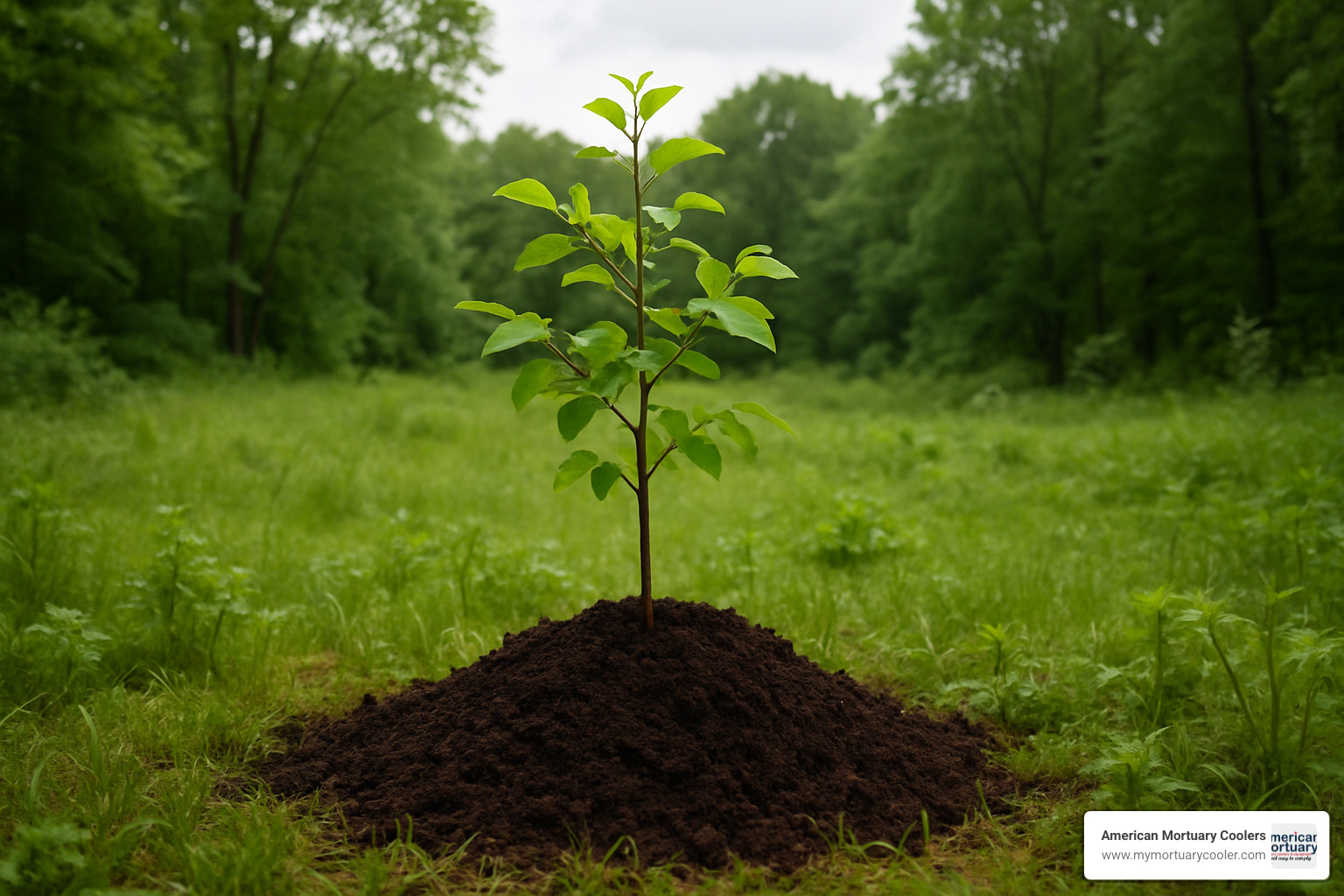
The environmental impact of how long does it take to compost a body becomes meaningful when considering the aftermath of those 8-12 weeks. Each person choosing human composting prevents approximately one metric ton of CO2 emissions compared to cremation or traditional burial.
Human composting uses 87% less energy than cremation and requires no fossil fuels during decomposition. Land conservation represents another major benefit, as the process creates soil that can restore damaged ecosystems.
The legal landscape continues expanding rapidly. As of 2024, twelve states have legalized natural organic reduction: Washington, Colorado, Oregon, Vermont, California, New York, Nevada, Arizona, Maryland, Delaware, Minnesota, and Maine. Several other states are actively considering legislation.
Cost considerations make human composting accessible, with most facilities charging between $4,000-$5,500 for the complete process, competitive with traditional burial while offering environmental benefits.
Soil use restrictions vary by state. While finished compost is safe for most applications, some jurisdictions restrict its use on crops for human consumption. Most families use the soil for memorial gardens or donate it to conservation projects.
Religious and cultural acceptance varies significantly. Some faith traditions accept human composting as environmental stewardship, while others prefer traditional methods. The Catholic Church has expressed concerns, though many individual Catholics choose the process. Protestant denominations show more openness, emphasizing creation stewardship.
For detailed comparisons, our A Comprehensive Guide to Human Composting Options and Cheat Sheet to Body Composting Costs provide comprehensive information.
Frequently Asked Questions about How Long Does It Take to Compost a Body
Can the soil be used safely in food gardens?
The finished compost meets all EPA safety standards for heavy metals and pathogens. The high-temperature composting process destroys harmful bacteria and creates technically safe soil.
However, many states restrict using the soil for crops intended for human consumption - not because it's unsafe, but as a regulatory precaution. The soil works beautifully for ornamental plants, memorial trees, and flower gardens. Many families donate it to conservation projects for ecosystem restoration.
Where is human composting available right now?
Human composting is legal in twelve states: Washington, Colorado, Oregon, Vermont, California, New York, Nevada, Arizona, Maryland, Delaware, Minnesota, and Maine.
Important note: legalization doesn't guarantee operating facilities yet. Washington and Colorado have the most established services, with Recompose in Seattle pioneering the industry. Other states are developing facilities as demand grows.
What happens if the deceased had medical implants?
Medical implants are carefully handled during composting. After the 5-7 week composting phase, staff thoroughly screen materials to remove inorganic items.
Pacemakers, artificial joints, surgical hardware are extracted and can be returned to families if requested. Dental work gets special attention, particularly amalgam fillings containing mercury, which are disposed of through specialized medical waste channels to prevent environmental contamination.
Conclusion
Understanding how long does it take to compost a body - typically 8-12 weeks - helps funeral directors and families plan thoughtfully for this emerging disposition option. The process offers a meaningful middle ground between immediate cremation and the decades-long decomposition of traditional burial.
As more families seek environmentally conscious alternatives, human composting represents a profound shift in how we think about death and our relationship with the earth. The 8-12 week timeline allows families to process their grief while knowing their loved one is becoming part of the natural cycle that sustains life.
At American Mortuary Coolers, we understand that this transition period requires careful planning and proper equipment. We support funeral providers across Tennessee, Atlanta, Chicago, Columbia, Dallas, Los Angeles, New York, and Pittsburgh with reliable mortuary refrigeration that ensures dignified care during the weeks families need to arrange natural organic reduction services.
Our custom cooling solutions bridge the gap between death and disposition, whether families ultimately choose composting, burial, or cremation. As the funeral industry evolves to meet changing environmental values, having flexible infrastructure becomes essential.
The future of death care is clearly moving toward sustainability and environmental responsibility. More states are legalizing human composting each year, and facilities are expanding to meet growing demand. Funeral homes that prepare now will be ready to serve families who want to give back to the earth rather than take from it.
For funeral directors considering how to incorporate these services, our Cheat Sheet to Body Composting Costs provides practical guidance on the economics and logistics of offering human composting options.
The question of how long does it take to compost a body might seem purely technical, but it represents something much deeper. It's about honoring our loved ones while nurturing the planet that sustained them in life. That 8-12 week journey from death to soil isn't just decomposition - it's change into something that will help new life flourish for generations to come.


